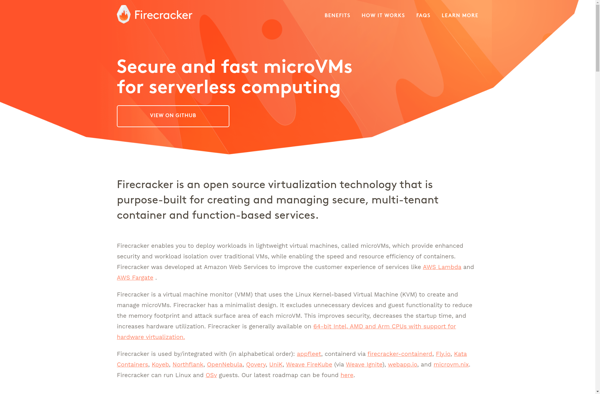AWS Firecracker

AWS Firecracker: Open Source Virtualization for Serverless Computing
AWS Firecracker is an open source virtualization technology that provides lightweight, secure microVMs for serverless computing. It enables high density multi-tenancy and fast startup times to support functions and containers.
What is AWS Firecracker?
AWS Firecracker is an open source virtualization technology that provides lightweight and secure microvirtual machines (microVMs) optimized for serverless computing. It was developed by Amazon Web Services to enable high-density multi-tenancy, fast startup times, and security for functions and container workloads.
Some key features and capabilities of Firecracker include:
- MicroVM architecture that provides process-level isolation for workloads
- Extremely fast startup times, allowing workloads to start in less than 125 milliseconds
- Minimal resource overhead, using as little as 5MB memory per microVM
- Integration with container runtimes like Docker and container managers like Kubernetes
- A secure production environment that utilizes hardware virtualization features for security
- An open source model that enables community collaboration and innovation
Firecracker is well-suited for running ephemeral containerized workloads and serverless functions. Its security and density allows these workloads to safely run together on the same hosts. The fast launch times also support auto-scaling capabilities to handle rapid workload changes.
Overall, Firecracker fills a gap by providing an optimized virtualization and execution environment for functions, containers, and other emerging workload types in the serverless computing space.
AWS Firecracker Features
Features
- Lightweight virtualization technology
- Provides microVMs for serverless computing
- Enables high density multi-tenancy
- Fast startup times
- Supports functions and containers
Pricing
- Open Source
Pros
Cons
Official Links
Reviews & Ratings
Login to ReviewThe Best AWS Firecracker Alternatives
Top Ai Tools & Services and Serverless Computing and other similar apps like AWS Firecracker
Here are some alternatives to AWS Firecracker:
Suggest an alternative ❐Kubernetes

QEMU

Proxmox Virtual Environment

Docker

XCP-ng

Kata Containers
